Tree pulling is one tool that graziers in the northern parts of Australia can use to look after and repair their land. We refer to it as "tree pulling" rather than "tree clearing" because in most cases the main purpose of it is to encourage grass growth, not to permanently remove trees.
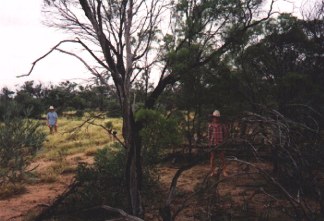 The area to the right in this photo shows bare
ground under trees. The area in the left of the
photo has been pulled and has a healthy grass
cover as well as young trees regrowing.
According to the Wilderness society, the national tree clearing figures for 2000 were
QLD 425,000 ha
NSW 37,000 ha
TAS 4,000 ha * ABC radio`s show Earthbeat claims Tasmainia pulls 13,400 ha annually
VIC 1,828 ha
WA 1,000 ha
In our opinion, these figures are half correct. Each state has differring land management reasons for pulling trees. For example, not all the 425,000 ha of supposably "cleared land" is truly cleared land.
Below is a photo of 3,000 acres of land "cleared" in 1985. This photo was taken 15 years later, the regrowth is up to 7 metres tall - about 70% of the original tree height. A 1999 satelite image showed it to be "remnant forest".
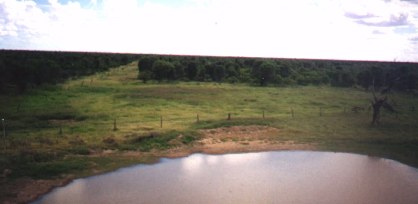 So if we were to compare apples with apples, then the data would change and the approximate amount of land which has changed it`s use (from timbered to cleared land) would become.
QLD 60,000 ha
NSW 15,000 ha
TAS 4,000 ha
VIC 1,800 ha
WA 1,000 ha
To explain this, the data shows that in Queensland 5% of tree pulling is to clear areas for town, city and mining development. (20,000 ha)
10% of tree pulling in Queensland is to make room for crops. (40,000 ha) Generally land cleared for cropping will remain clear permanently (apart from whatever shelter belts are left) although if ploughing stopped, then the trees would eventually return. (See paired photos of tennis court and cropped area below or click on Tree Increase in Australia ).
The rest of the tree pulling in Queensland (85%) (340,000 ha)is for repairing the soil and encouraging healthier pastures for grazing. We believe this type of pulling should be considered as quite different to the situations that do not allow trees to regrow or do not establish perennial grasses.
|
||
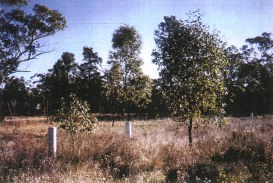 |
||
Balgay Tennis courts in central NSW during the 50th Anniversary Celebrations in 1986. As can be seen in the photo above the courts were bare of vegetation, having been annually salted and rolled for the previous fifty years.
|
 |
The photo above shows the same courts fourteen years later - 100% native vegetation cover. No need for tree planting programs in this environment!
|
|
In many areas of Australia the climate is relatively arid and low in humidity.
The soil can easily become bare and exposed to sun, wind and rain. When this happens the soil surface is easily eroded by wind and rain.
|
|
Raindrop impact seals the surface of the soil and the sun bakes it hard. (In some soil types, when ripped by a bulldozer, the soil breaks up looking like concrete slabs about 20 cm thick).
When the soil surface is sealed like this rainwater can not easily soak into the ground and the water runs off causing more severe flooding and erosion than normal in creeks. Poor water penetration into the soil means plants have less moisture to grow and small animals and microorganisms in the soil can not thrive.
|
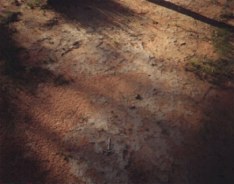 Photo above shows hard capped soil surface in central-western Queensland shaded by trees. A crowbar thrown at this soil surface would hardly make a dent.
|
How does the soil surface become capped and bare?
A healthy soil has a "skin" of living plants and litter from dead grass, leaves, twigs etc. The skin is lost when plants die and no young seedlings replace them and when the litter is blown or washed away because not enough plants remain to hold the litter in place.
|
Why do the plants die?
Plants can be killed, and seedlings can fail to survive, through being grazed or burnt either too often or not often enough (see Grazing and Animal Impact and Fire). New seedlings can fail to establish in hard soil when there has been nothing (such as hoof action) to loosen the soil surface so that seeds can be covered.
|
|
Too many trees can also kill grass. As tree cover becomes thicker the trees compete with grasses for moisture and light and therefore the grass cover gradually declines. (see Tree Increase in Australia )
Trees in the right proportions can actually increase the production of grasses but when they become very thick they can reduce grass density to almost zero. Trees are nowhere near as good at protecting the soil surface as grasses are. Trees do not prevent erosion in a "brittle" (non-humid, erratic rainfall) environment.
The photo to the right from central N.S.W. shows bare ground under the trees in the background with a gully beginning to form. In the foreground, where there are fewer trees, the grass is thicker.
|
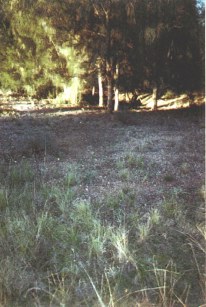 |
How does tree pulling repair the soil surface?
Treepulling performs several positive functions including.
|
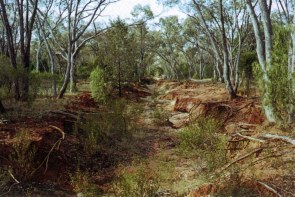 |
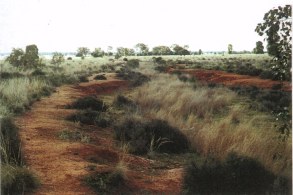 |
|
The photo above shows erosion caused by water running off the poorly grassed land under these trees. Trees alone have been helpless to prevent the loss of soil and the trees themselves are threatened by the erosion as you can see from the number of exposed tree roots. This land is in central N.S.W.
|
 |
The photo above has been taken from exactly the same spot as the one on the left except facing in the opposite direction.
The only remedial action taken on this country was the removal of dense woody vegetation ten years previously followed by cropping for three years.
Notice the healing gully, the thicker pasture and the young trees re-emerging in the cropped area.
|
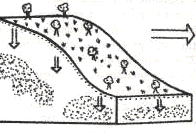 |
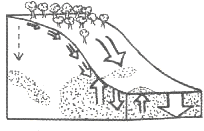 |
1800`s - The land had few trees and dense grass cover.
water infiltration occurred across the landscape. water tables were fairly stable
|
by 1960`s - grass cover declined and trees thickened due to fire regime change. lower (cleared) areas had more water infiltrate into surface aquifers raising water tables (and dryland salinity occurred) The cause is the lack of dense deeprooted grasses.
|
But don't we need trees too?
Yes, we most certainly do. There are a number of reasons for keeping trees or allowing regrowth of some trees. These include
In most Australian states, landholders have to submit a plan of how they want to manage their vegetation. Provided the plan ensures the minimum retention area and no endangered ecosystems or endangered animals habitats are destroyed, a permit is supposed to be given. Some states have a list of other requirements as well (and unfortunately some states have government departments overstepping the law and putting restrictions on landholders that are illegal.)
We believe more research should be done with regards to maintaining biodiversity because very little has been done to date. (E.G. how does grass cover, size of retention areas, climate, vegetation type & density, and grazing management systems affect biodiversity?)
On the rangelands of Northern Australia the problem is not so much keeping enough trees after pulling, as preventing them from growing back too thickly. Tree regrowth after pulling is usually thicker and more likely to crowd out grasses than the original stand of timber was unless it is well managed with fire and appropriate grazing. Some environmental groups acknowledge this regrowth problem (see Queensland Conservation Council web site) but fail to understand that natural timber thickening is creating the same environmental problems as regrowth does. (See second photo on this page).
The "tree clearing" debate should be raising the question, "What is the best way to manage trees for a sustainable productive landscape?" rather than, "How many trees should landholders be allowed to pull down?"
One approach to forest management that could be helpful is called "Variable retention in forestry" One of the founders of Greenpeace (Patrick Moore) advocates this method of management. Please follow the link to learn more about it.
Answering critics of treepulling
Senator Robert Hill has said tree clearing in Queensland is unsustainable - However the facts are
Dr Barry Traill (Wilderness society of Queensland) said on ABC radio that if tree clearing continues as it is, then in 20 years time, there will be no bush left as we know it .
The above figures demonstrate his lack of understanding about Queensland ecosystems which have trees that germinate constantly (treethickening), regrow after pulling, and encroach on to new areas.(see tree increase) His maths is inaccurate too (60 million ha / 400,000 ha = 150 not 20)
Senator Hill has stated Queensland needs to cap the treeclearing rate to reduce Australia`s greenhouse gas emissions.
Queensland has a biomass increase of approx 22,000,000 tonnes each year
Thats approx 10,000,000 tonnes of extra carbon stored in vegetation each year.
Sure by reducing tree pulling rates, even more carbon would be stored, but Queensland is already a vegetation sink, so any extra should be paid for via carbon credits as those areas not able to pull timber will eventually become non grazing lands once the tree density reaches it`s maximum.
Senator Hill has also said Queensland`s treeclearing should be brought into line with other states.
What does he mean?
Which states does he want Queensland to follow?
|